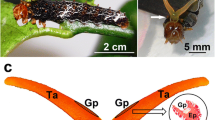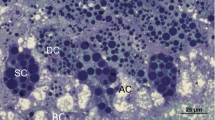Summary
-
1.
The concentrations of sodium, potassium, calcium, magnesium, chloride, trehalose, total phosphates, labile phosphates, amino acids, proteins and polypeptides, and the osmotic pressures were determined in pharate pupal hemolymph and molting fluid, and pupal hemolymph and midgut lumenal contents.
-
2.
The osmotic pressures of molting fluid and midgut lumenal contents were 40 and 56% greater, respectively, than those of hemolymph. To account for this increase in molting fluid, I proposed that cells in the epidermis actively transport potassium into the exuvial space with an accompanying passive bulk flow of water.
-
3.
With the approach of ecdysis, the osmotic pressure of molting fluid remained constant, while the concentrations of organic components in molting fluid declined and those in hemolymph were simultaneously enhanced.
-
4.
Differences in the levels of potassium, magnesium, labile phosphate and all organic components were so great as to preclude passive diffusion between molting fluid and hemolymph.
-
5.
Fluid in the pupal midgut lumen appears to be derived primarily from the sloughed larval midgut epithelia and actively transported pigment derived from the larval integument.
-
6.
Chloride, labile phosphate and amino acids were the major anionic components of hemolymph, while for molting fluid, they constituted less than 9% of the anions present.
-
7.
The origins of fluids accumulating in the exuvial space of the cuticle and the lumen of the midgut are different, and both fluids are isolated from hemolymph.
Similar content being viewed by others
References
Agrell, I.: Physiological and biochemical changes during insect development. In: Physiology of the insecta (Rockstein, M. ed.), vol. 1, p. 121–140. New York: Academic Press 1964
Bade, M. L., Wyatt, G. R.: Metabolic conversions during pupation of the cecropia silkworm. 1. Deposition and utilization of nutrient reserves. Biochem. J.83, 470–478 (1962)
Chen, P. S., Levenbook, L.: Studies on the haemolymph proteins of the blowflyPhormia regina. 1. Changes in ontogenic patterns. J. Insect. Physiol.12, 1595–1609 (1966)
Chino, H., Gilbert, L. I.: Lipid release and transport in insects. Biochim. biophys. Acta (Amst.)98, 94–110 (1965)
Chinzei, Y., Tojo, S.: Nucleic acid changes in the whole body and several organs of the silkworm,Bombyx mori, during metamorphosis. J. Insect Physiol.18, 1683–1698 (1972)
Cottrell, C. B.: Insect ecdysis with particular emphasis on cuticular hardening and darkening. Advanc. Insect Physiol.2, 175–218 (1964)
Florkin, M., Jeuniaux, Ch.: Hemolymph: composition. In: Physiology of the insecta (Rockstein M. ed.) vol. Ill, p. 109–152. New York: Academic Press 1964
Gilbert, L. I.: Lipid metabolism and function in insects. Advanc. Insect Physiol.4, 69–211 (1967)
Goa, J.: A micro-biuret method for protein determination. Determination of total protein in cerebrospinal fluid. Scand. J. clin. Lab. Invest.5, 218–222 (1953)
Hackman, R. H.: The integument of arthropoda. In: Chemical zoology (Florkin M. and Scheer B. T. eds.) vol. VI, p. 1–62. New York: Academic Press 1971
Jeuniaux, C.: Resorption du liquide exuvial chez le ver á soie (Bombyx mori, L.). Arch. Int. Physiol. Biochem.66, 121–122 (1958).
Jungreis, A. M.: Distribution of magnesium in tissues of the silkmothHyalophora cecropia. Amer. J. Physiol.224, 27–30 (1973).
Jungreis, A. M.: Formation and composition of molting fluid in the silkmothHyalophora cecropia. Am. Zoologist13, 270A (1973)
Jungreis, A. M., Jatlow, P., Wyatt, G. R.: Inorganic ion composition of haemolymph of the cecropia silkmoth: Changes with diet and ontogeny. J. Insect. Physiol.19, 225–233 (1973)
Jungreis, A. M., Tojo, S.: Potassium and uric acid content in tissues of the silkmothHyalophora cecropia. Amer. J. Physiol.224, 21–26 (1973).
Jungreis, A. M., Wyatt, G. R.: Sugar release and penetration in insect fat body. Relations to regulation of haemolymph trehalose in developing stages ofHyalophora cecropia. Biol. Bull.143, 367–391 (1972)
Katzenellenbogen, B. S., Kafatos, F. C.: Inactive proteinases in silkmoth moulting gel. J. Insect Physiol.17, 823–832 (1971a)
Katzenellenbogen, B. S., Kafatos, F. C.: Proteinases of silkmoth moulting fluid: Physical and catalytic properties. J. Insect Physiol.17, 775–800 (1971b)
Katzenellenbogen, B. S., Kafatos, F. C.: General esterases of silkmoth moulting fluid: Preliminary characterization. J. Insect Physiol.17, 1139–1151 (1971c)
Kilby, B. A.: The biochemistry of insect fat body. Advanc. Insect Physiol.1, 111–174 (1963)
Layne, E.: Spectrophotometer and turbidometer methods for measuring proteins. In: Methods in enzymology. (Colowick, S. P. and Kaplan, N. D. eds.), vol. III, p. 447–453. New York: Academic Press 1957
Lensky, Y., Cohen, C., Schneiderman, H. A.: The origin, distribution and fate of the molting fluid proteins of the cecropia silkworm. Biol. Bull.139, 277–295 (1970)
Levenbook, L., Hollis, V. W.: Organic acids in insects. I. Citric acid. J. Insect Physiol.6, 52–61 (1961)
Locke, M.: The structure and formation of the integument of insects. In: Physiology of the insecta (Rockstein, M. ed.), vol. III, p. 379–470. New York: Academic Press 1964
Locke, M.: The structure and formation of the cuticulin layer in the epicuticle of an insectCalpodes ethlius (Lepidoptera, Hesperiidae). J. Morph.118, 461–494 (1966)
Locke, M.: The molt-intermolt cycle in epidermis and other tissues of an insectCalpodes ethlius (Lepidoptera, Hesperiidae). Tissue and Cell2, 197–223 (1970)
Lowry, O. H., Roberts, N. R., Leiner, K. Y., Wu, M. L., Farr, A. L.: The quantitative histochemistry of brain. 1. Chemical methods. J. biol. Chem.207, 1–17 (1954)
Lowry, O. H., Rosebrough, N. J., Farr, A. L., Randall, J. R.: Protein measurement with the Folin-phenol reagent. J. biol. Chem.193, 265–275 (1951)
Maddrell, S. H. P.: The mechanisms of insectory systems. Advanc. Insect Physiol.8, 199–331 (1971)
Mokrasch, L. C.: Analysis of hexose phosphates and sugar mixtures with anthrone reagent. J. biol. Chem.208, 55–59 (1954)
Moore, S., Stein, H. W.: Photometric ninhydrin method for use in the chromatography of amino acids. J. biol. Chem.176, 367–388 (1948)
Noble-Nesbitt, J.: Aspects of the structure, formation and function of some insect cuticles. In: Insects and physiology (Beament, J. W. L., and Treherne, J. E. eds.), p. 3–16. London: Oliver and Boyd 1967
Passonneau, J. V., Williams, G. M.: The molting fluid of the cecropia silkworm. J. exp. Biol.30, 545–560 (1953)
Quatrale, R. P.: Cation concentration changes during development in the silkworm.Hyalophora cecropia (PhD Thesis) Amherst: University of Massachusetts. 187 p. (1966)
Shaaya, E., Karlson, P.: Die Ecdysontiter während der Insekten-Entwicklung. II. Die Postembryonale Entwicklung der SchmeißfliegeCalliphora erythrocephala Meig. J. Insect Physiol.11, 65–69 (1965)
Shaaya, E., Sekeris, C. E.: Ecdysone during insect development. III. Activities of some enzymes of tyrosine metabolism in comparison with ecdysone titer during the development of the blowfly,Calliphora erythrocephala Meig. Gen. comp. Endocrinol.5, 35–39 (1965)
Shaw, J., Stobbart, R. H.: Osmotic and ionic regulation in insects. Advanc. Insect Physiol.1, 315–399 (1963)
Speck, U., Urich, K.: Resorption des alten Panzers vor der Häutung bei dem FlußkrebsOrconectes limosus: Schicksal des freigesetzten N-Acetyl-glucosamins. J. comp. Physiol.78, 210–220 (1972)
Sutcliffe, D. W.: The composition of hemolymph in aquatic insects. J. exp. Biol.39, 325–343 (1962)
Sutcliffe, D. W.: The chemical composition of haemolymph in insects and some other arthropods in relation to their phylogeny. Comp. Biochem. Physiol.9, 121–135 (1963)
Tsujita, M., Sukurai, S.: Purification of three specific soluble chromoproteins from chromogranules in hypodermal cells of the silkworm larva. Proc. Japan. Acad.41, 225–229 (1965a)
Tsujita, M., Sukurai, S.: Amino acid analysis of three specific chromoproteins purified from chromogranules in hypodermal cells of silkworm larva. Proc. Japan Acad.41, 230–235 (1965b)
Verson, E.: Observations on the structure of the exuvial glands and the formation of the exuvial fluid in insects. Zool. Anz.25, 652–654 (1902)
Wigglesworth, V. B.: The physiology of the cuticle and of ecdysis inRhodnius prolixus (Triatomidae, Hemiptera) with special reference to the function of oenocytes and of the dermal glands. Quart. J. microsc. Sci.76, 269–318 (1933)
Wyatt, G. R.: The biochemistry of insect hemolymph. Ann. Rev. Entom.6, 7–5102 (1961)
Wyatt, G. R.: The biochemistry of sugars and polysaccharides in insects. Advanc. Insect Physiol.4, 287–360 (1967)
Wyatt, G. R.: Biochemistry of insect metamorphosis. In: Metamorphosis (Etkin W. and Gilbert L. I., eds.), p. 143–184. New York: Appleton-Crofts 1968
Wyatt, G. R., Kalf, G.: The chemistry of insect hemolymph. II. Trehalose and other carbohydrates. J. gen. Physiol.40, 833–847 (1957)
Wyatt, G. R., Kropf, R. B., Carey, F. G.: The chemistry of insect hemolymph. IV. Acid-soluble phosphates. J. Insect Physiol.9, 137–152 (1963)
Author information
Authors and Affiliations
Additional information
This research was supported by grants from the National Institutes of Health, U.S. Public Health Service (HD-00032) and from the Ohio University Research Committee (No. 410). During the tenure of this work, AMJ was partially supported by Training Grant HD-00032 from the Institute of Child Health and Human Development. The technical assistance of Mrs. Winnifred Breau is gratefully appreciated.
Rights and permissions
About this article
Cite this article
Jungreis, A.M. Physiology and composition of molting fluid and midgut lumenal contents in the silkmothHyalophora cecropia . J. Comp. Physiol. 88, 113–127 (1974). https://doi.org/10.1007/BF00695403
Received:
Issue Date:
DOI: https://doi.org/10.1007/BF00695403




